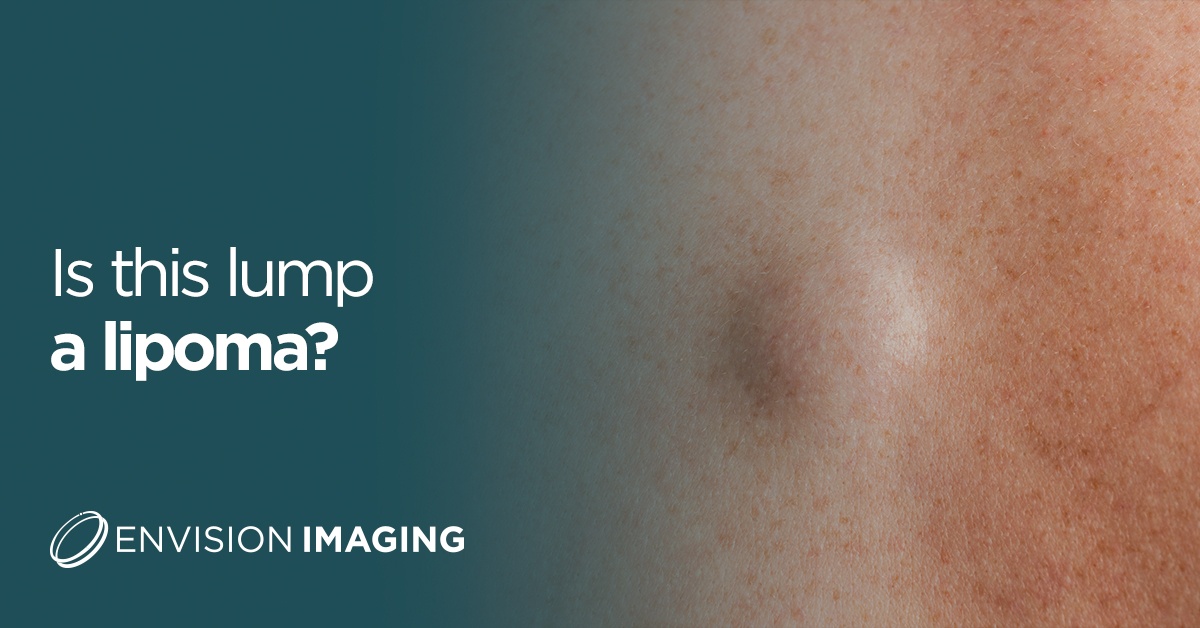Is this lump a lipoma?

Lipomas can be an alarming discovery. If you find a lump underneath your skin or anywhere on your body, your first thought may be to panic. Understanding lipomas and how to treat them can help put your mind at ease.
What is a lipoma?
A lipoma is actually a lump of slow-growing fat that grows in your body’s soft tissues. This is typically just between your skin and the underlying muscle layer. Lipomas usually feel soft and rubber-like and are generally not sore or tender to the touch unless pressing on a nerve, joint or connected to blood vessels and other tissue.
These lumps are classified as tumors by doctors, but they are usually harmless. A lipoma isn’t cancerous and treatment is usually unnecessary. Lipomas are usually detected in middle age and some people may have more than one. Most lipomas are not painful and don’t bother people with them. However, if they do bother you, your medical practitioner can remove them.
A lipoma is the most common tumor found beneath the skin. In fact, 1 in every 1000 people will get one at some point in their lives. They are most commonly found in your upper body, arms, thighs, back, neck, shoulders, chest, torso and forehead.
There are seven types of lipomas, some of which contact fat and blood vessels and other tissues. These include:
- Angiolipoma: This type contains fat and blood vessels. Angiolipomas are often painful.
- Conventional: The most common type, a conventional lipoma contains white fat cells. White fat cells store energy.
- Fibrolipoma: Fat and fibrous tissue make up this type of lipoma.
- Hibernoma: This kind of lipoma contains brown fat. Most other lipomas contain white fat. Brown fat cells generate heat and help regulate body temperature.
- Myelolipoma: These lipomas contain fat and tissues that produce blood cells.
- Spindle cell: The fat cells in these lipomas are longer than they are wide.
- Pleomorphic: These lipomas have fat cells of various sizes and shapes.
What are the symptoms of lipomas?
Lipomas are not usually painful, but they can be uncomfortable depending on where they have formed. If it’s near a joint or pressed against a nerve it may be a little uncomfortable. Many people don’t usually experience any symptoms.
How to identify a lipoma
Lipomas are usually encapsulated and don’t spread to the tissue around them. They are usually painless unless pressing on a nerve or joint. They may also cause discomfort based on their size, location and proximity to blood vessels and nerves. These lumps are usually round or oval-shaped and feel rubbery to the touch. They are also moveable and often move underneath the skin when pressed. In most cases, they are less than 2 inches in diameter, but they can be up to 6 inches.
Common causes of lipomas
There is no definite answer to what causes a lipoma, as this is largely unknown. Researchers have found that lipomas are usually caused by injury to the skin, although doctors are unsure if that is what makes them form. Lipomas typically appear after injury or are caused by a genetic condition inherited from elders. Around 2 to 3% of people who develop a lipoma have a family history of the condition. The condition is also most common in people between the ages of 40 and 60 years old, but anyone at any age can develop one.
A few conditions that cause lipomas include the following.
1. Madelung’s Disease:
The largest demographic affected by lipomas are men of Mediterranean ancestry who consume alcohol excessively. This disease is also referred to as multiple symmetric lipomatosis, which causes lipomas to grow around the neck and shoulders.
2. Dercums Disease:
This rare disorder causes painful lipomas to grow, which are most often on the arms, legs and trunk. This condition can also be referred to as Ander’s Syndrome.
3. Gardner Syndrome:
This is a form of a disorder called familial adenomatous polyposis, which can cause lipomas and a range of other health problems.
4. Hereditary Multiple Lipomatosis:
This disorder is also called familial multiple lipomatosis, which is a genetic order that’s passed down through families.
How to diagnose a lipoma
Diagnosing a lipoma is usually done by a medical practitioner during a physical examination. Your doctor will touch the lipoma and ask if it is painful or tender to the touch. You may need a biopsy to confirm the lipoma isn’t cancer. A biopsy is when your doctor removes a sample of the lipoma and sends it to your medical lab for testing.
Very often, a lipoma may be confused for a cyst. To see a clear picture of this lump, your provider may order an imaging test such as a lipoma ultrasound, MRI and CT Scan. Through these tests, your doctor can determine if it is a lipoma or a cyst. These tests will also help determine if the lipoma is attached to blood vessels, pressing against nerves, pressing against other tissues and its exact location underneath the skin. These tests also help to indicate how deep underneath the skin they are and what the best treatment method would be.
What are my treatment options?
Most lipomas do not require medical treatment. If a lipoma is bothering you and you wish to have it removed, your doctor can surgically remove the lipoma. The removal procedure is safe and effective, and you can usually go home the same day. This is an uncomplicated surgery and does not require an overnight stay at a hospital.
If you don’t wish to have it surgically removed, you can have it removed through liposuction. This procedure is when your doctor uses a long, thin needle to remove fatty tissue from the lump. This method usually results in less after-care treatment and can be done during your visit.
When to see your practitioner
You should book an appointment to see your doctor if you have a skin growth underneath the skin to avoid any serious conditions such as Liosarcoma, a type of cancer. It is essential to rule out any serious conditions when you find any abnormalities on your body, especially lumps that may develop. Speaking to a medical practitioner can help eliminate any serious conditions and put your mind at ease.
Should I worry about a lipoma?
Lipomas are a common condition that usually cause no discomfort unless it’s a rare case affecting blood vessels, nerves or other tissues. Lipomas can be identified through a physical exam, MRI, CT Scan or Ultrasound. Lipomas are easy to remove, should you wish to get rid of them, and they usually don’t cause any other health issues later on. If you are unsure, always seek professional medical advice to rule out serious conditions.
Reach out to Envision Imaging today
When you need answers about an unusual growth, turn to the experts at Envision Imaging for professional imaging services and accurate results. We offer world-class diagnostic imaging and can give you the peace of mind you need after discovering an abnormality on your body.
Browse our locations to request your next diagnostic imaging appointment. Our world-class facilities, compassionate care and accurate results ensure a pleasant and reliable experience.
Sources:




